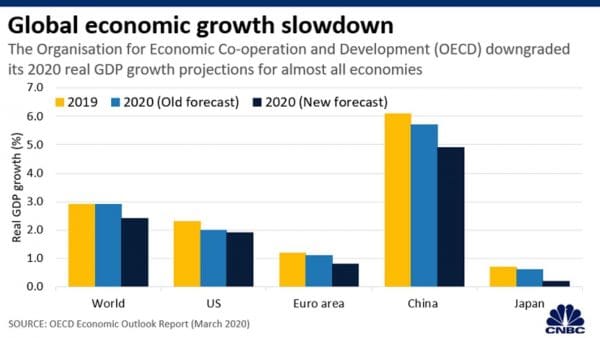Interested in how to run programs and increase resilience during uncertainty? The spread of the coronavirus has quickly become one of the biggest threats to the global economy and financial markets. For example, at the time of this article, the pandemic was spreading so rapidly around the world. Increasing resilience means supporting employees, improving communications, providing more flexible work arrangements, among other things.
“From an economic perspective, the key issue is not just the number of cases, but the level of disruption to economies from containment measures,” Ben May, the head of global macro research at Oxford Economics said (CNBC, 2020) fears of the coronavirus impact on the global economy have affected markets worldwide. The Organization for Economic Co-operation and Development’s (OECD) 2020 growth forecasts have decreased for almost all economies, as shown in Figure 2.

Figure 3.2 Global Economic Slowdown projection of OECD – March 2020
The coronavirus has been testing company’s resilience, which is the ability of an organization and its accompanying critical business processes to withstand or recover from a business interruption. Figure 3 shows a model for the elements of resilience.

Figure 3 Four Rs of Resilience (Kliem & Richie, 2016)
When an organization confronts an interruption when operating normally to increase resilience during uncertainty, the first thing is to respond, that is to, apply processes, procedures, and actions as quickly as possible to prevent, mitigate, or avoid the impact of a negative incident (Kliem & Richie, 2016). In the case of the coronavirus outbreak, industries are at this phase now.
So how can companies transition to the recovery phase and increase resilience during uncertainty?
It requires taking actions that will lead to the resumption of its business process and, ultimately, return to normal operations. There may be various answers to this question; however, a program management approach will certainly help companies find ways to cope with this outbreak and start the recovery phase.
Programs are initiated to gain benefits. These days the most important benefits are the ones that contribute to starting the recovery of the company, not the benefits that contribute to strategic objectives. Thus first, we should focus on the identification of benefits to adapt to this new situation. So, how can your company run programs and increase resilience during coronavirus?
How to run programs and increase resilience during uncertainty
Identify benefits leading to recovery
The benefits may be both tangible and intangible. In the days of crises, intangible benefits may gain more importance, like the ones that support the employees.
Focus on supporting employees
Organizations will need to “develop a plan for better supporting employees that is consistent with conservative health and safety guidelines” (BCG, Mysore & Usher, 2020). The plan needs to be flexible enough to allow for policy changes. Deal with human tragedy as a priority. Arrange the resources of your projects such that this arrangement can create the benefit of saving your team members and employees.
Increase communications dramatically
Establish and maintain communications platforms and manage multichannel communication. In a crisis, it’s hard to find clarity since the information and the situation are constantly changing. Reeves and his friends (2020) suggest that employees and customers should be communicated with consistent and timely information.
Use the power of a network of teams
It’s difficult and not effective to quickly collect information and make wise decisions based on this information for executives. Leaders can better empower others who can reach the necessary information almost in real-time to make decisions.
To promote effective and agile problem solving, especially under high-stress and chaotic conditions like now, leaders can organize a network of teams. BCG (2020) calls this “nerve-center integration team,” which is based on five cross-functional teams. This integration team can include members from different functions and projects.
Providing more flexible work arrangements and reallocating activities
Some service companies were hit very hard, such as restaurants in which employees were unable to carry on their regular activities. This mostly led to layoffs. On the other hand, some creative Chinese enterprises actively reallocated activities to employees that were more valuable, like recovery planning or even loaned them to other companies. Reeves and his friends (2020) found that more than 40 restaurants, hotels, and cinemas shared their staffing with Hema, a new retail supermarket chain, which was in urgent need of labor for delivery services due to the sudden increase in online purchases. Some of your projects may stop due to the current conditions; however, program managers should think about shifting the resources of these stopped projects to other available projects or other operating functions of the company if possible. Providing employees with more flexible work arrangements and allocating activities that are more value-added improves resilience.
Prepare for a faster recovery
While the depth and duration of the economic impact are difficult to forecast, China’s experience points to a scenario that companies should prepare for the recovery even if you’re still reacting to the crisis. Reeves and his friends (2020) found that a premium Chinese travel agency encouraged employees to use their time to upgrade internal systems, improve skills, and design new services instead of reducing headcount. Program Managers should consider improving the skills of the project teams for the future.
Increasing resilience during uncertainty should be one of the strategic objectives for organizations not only during crisis times but also especially before it happens. When you know how to run programs and focus on identifying and realizing benefits, it can greatly improve resilience during uncertainty.
References:
*BCG (Boston Consulting Group), 2020. Covid-19 Consumer Sentiment Snapshot #1 (https://bcghendersoninstitute.com/how-will-things-be-different-when-its-all-over-513900bfb0af)
*CNBC, 2020. Services ve Manufacturing Compare (https://www.cnbc.com/2020/03/12/coronavirus-impact-on-global-economy-financial-markets-in-6-charts.html)
*D’Auria, G., Smet, A., 2020. Leadership in a Crisis. McKinsey & Company. (https://www.mckinsey.com/business-functions/organization/our-insights/leadership-in-a-crisis-responding-to-the-coronavirus-outbreak-and-future-challenges)
*Kliem, G. D., Richie, R. L., 2016. Business Continuity Planning A Project Management Approach. CRC Press.
*Reeves, M., Faeste, L., Chen, C., Carlsson, P., Whitaker, K., 2020. How Chinese Companies Have Responded to Coronavirus. Harvard Business Review. (https://hbr.org/2020/03/how-chinese-companies-have-responded-to-coronavirus)

